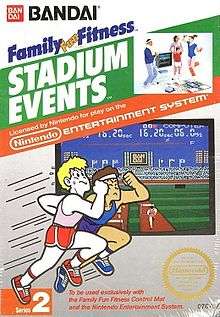Stadium Events
Stadium Events[lower-alpha 1] is a sports fitness game developed by Human Entertainment and published by Bandai for the Nintendo Entertainment System. This and Athletic World are the two games in the Family Fun Fitness series, designed and branded for the short-lived Family Fun Fitness mat accessory for the NES. Stadium Events allows players to compete in four different Olympic inspired sporting events, using the mat to move as they compete in running and jumping focused gameplay.
| Stadium Events | |
|---|---|
 North American box art | |
| Developer(s) | Human Entertainment |
| Publisher(s) | Bandai (Stadium Events) Nintendo (World Class Track Meet) |
| Platform(s) | NES |
| Release | |
| Genre(s) | Exergaming, sports |
| Mode(s) | Single-player, multiplayer |
The North American version was rebranded by Nintendo after its 1987 release. The game was re-released as World Class Track Meet and the new mat was titled the Power Pad. Original North American copies of Stadium Events are now considered to be among the rarest NES games, leading to high prices in the secondary video game collecting market.
Gameplay
Stadium Events is a fitness game that allows the players to compete in four different sporting events: 100M dash, 110M hurdles, long jump, and triple jump.[1]:1–3 The game utilizes the Family Fun Fitness control mat which supports up to two players simultaneously, although up to six alternating players can be registered for each event.[1]:4–7 The left side of the mat must be used for the dash and hurdle events, while the other events can use either side. The top speed of the player's runner is dependent upon which row of buttons on the mat is used. If the player lifts their feet slightly before the starting signal, it is considered a false start.[1]:8–11

The 100M dash event places two players against each other in a race. The 110M hurdles event is similar to the dash, but the players must jump when white box markers appear along the edge of the screen. The long jump has the players running and then jumping and staying in the air as long as possible to record a longer distance. The triple jump is similar to the long jump but includes three separate jump markers.[1]:12–19 In tournament mode, the player must compete against computer players at the 100M dash and 110M hurdle events. The player must beat each of the six computer players at both the dash and hurdle events in order to win. In this mode, three false starts results in a disqualification.[1]:8–11 In another mode, "The Olympics", numerous players can compete in all four events consecutively. In this mode, the Guinness 1982 world track record is used as a reference for scoring standards.[1]:20–21
Release
Stadium Events was released for the Nintendo Entertainment System in North America in September 1987.[2] Nintendo saw promise in the Family Fun Fitness technology, so purchased the mat and re-branded it as the Power Pad. Stadium Events was also re-released as World Class Track Meet.[3]
The North American version of Stadium Events is considered one of the rarest NES games.[3][4][5][6][7] The total number of copies sold to consumers is unknown. The standard minimum initial run for an NES game was around 10,000 copies, but collectors believe the game's scarcity is much lower. A popular rumor that the game was sold at one Woolworth's store was proven false. Howard Phillips, a former spokesman for Nintendo of America, did not believe the cartridges were destroyed and claimed that reworking all of the cartridges would have been impractical.[3] Stadium Events copies have been sold for up to US$35,100 in the video game collecting market.[3][4][5][6][7]
The 2015 documentary Nintendo Quest considered it the single rarest NES title.[8]
Notes
References
- Stadium Events (NTSC NES instruction manual booklet). Bandai. 1987.
- "Stadium Events". GameSpot. Archived from the original on September 22, 2016. Retrieved May 7, 2016.
- Heckert, Justin. "The true story of Nintendo's most wanted game". ESPN.com. Archived from the original on November 29, 2016. Retrieved November 29, 2016.
- Claiborn, By Samuel. "7 of the Rarest Nintendo Treasures Ever Made". IGN. Archived from the original on May 15, 2016. Retrieved May 7, 2016.
- "Super-Rare NES Game Sold for $35,100". GameSpot. Archived from the original on May 15, 2016. Retrieved May 7, 2016.
- "Wii Feature: 25 rarest Nintendo games ever". ComputerAndVideoGames.com. June 29, 2008. Archived from the original on September 6, 2008. Retrieved February 20, 2011.
- "Instant Rarity: Are Those "Rare" Games Really Worth the Money? from". 1UP.com. Archived from the original on May 22, 2011. Retrieved February 20, 2011.
- Diver, Mike (August 19, 2016). "Meet the Guy Who Tried to Collect All 687 Official NES Games in 30 Days". Vice. Archived from the original on October 28, 2015. Retrieved October 27, 2015.